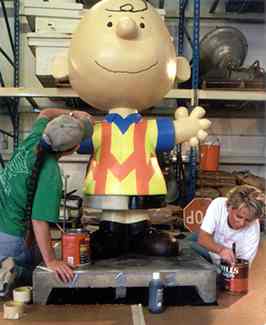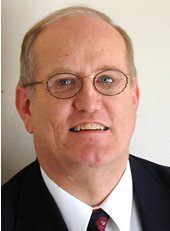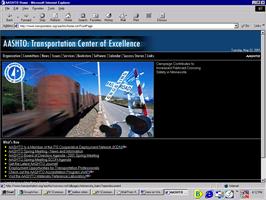 |
 |







|
 |
 |
 |
 |
 |
 |
 moving minnesota through employee communication moving minnesota through employee communication |
 |
 |
 May
23 , 2001 May
23 , 2001 |
No. 15 |
 |
|
|
 |
 |
 |
You’re a safe man, Charlie Brown
|
 |
 |
 |
Working for Peanuts...graphic artists Kim Lanahan-Lahti
(left) and Jane Greiner are painting one of 101 statues of Charles Schulz’s
character Charlie Brown created to publicize various St. Paul community
and business initiatives. Photo by Craig Wilkins
|
This summer St. Paul is hosting “Charlie Brown Around Town”—a follow-up to
Snoopy’s successful tour last year. Mn/DOT is partnering with the Head Lites
Corporation (a supplier of safety vests and equipment) to create a work zone
champion dubbed “Mn/DOT Charlie.”
Graphic artists Jane Greiner and Kim Lanahan-Lahti, Communications and Public
Relations, painted the beloved cartoon character of the late Charles Schultz
as an “icon of work zone safety.” The work was done at the Maryland Avenue
truck station. When completed, “Charlie” will be stationed at the transportation
building in St. Paul in early June. He will be wearing a safety vest and hat
and carrying a stop sign to remind visitors of the need for safety in highway
work zones.
“It was great fun putting a Mn/DOT spin on Charlie Brown,” reported
Kim Lanahan-Lahti, “and this Charlie Brown delivers our work zone safety message.”
By Mary Meinert
|
back

|
 |
Mn/DOT sends proposal to Wisconsin on Stillwater bridge
|
 |
 |
 |
Mn/DOT and the Wisconsin DOT suspended work on the
St. Croix River Crossing Project in January. Photo by Kent Barnard
|
Contingent on certain steps being taken by the state of Wisconsin, Mn/DOT is
willing to move forward on discussions with Oak Park Heights about the St. Croix
River Crossing project and schedule a public hearing on the supplemental Environmental
Impact Statement, Commissioner Elwyn Tinklenberg said today in a letter sent
to Wisconsin Secretary of Transportation Terry Mulcahy.
Mn/DOT’s actions depend on the Wisconsin Department of Natural Resources’ acceptance
of keeping the Stillwater lift bridge and the Wisconsin DOT’s willingness to
guarantee whatever portion of additional mitigation is not eliminated by subsequent
federal action, Tinklenberg said.
In January 2001, Mn/DOT and the Wisconsin DOT suspended work on the St. Croix
River Crossing Project because of insufficient federal funding for the lift
bridge mitigation alternatives; an inability of federal, state and local agencies
to reach a consensus; and failure to get municipal approval.
The mitigation alternatives the two transportation departments outlined last
September for the Federal Highway Administration are:
1. Relocation or removal of the lift bridge ($8.4 million in mitigation costs)
2. Conversion of the lift bridge to a pier ($19.l million in mitigation requiring
about $10.7 million in new federal funding)
3. Retention of the bridge for pedestrians and bicyclists ($26.9 million in
mitigation requiring $18.5 million in new federal funding).
Alternative three is the only viable option, Tinklenberg
said, because the other two (removal or partial removal of the bridge) are opposed
by both states’ historical preservation offices.
If the issue is not resolved by June, a new environmental review will be necessary.
View the May 23 news
release or the Jan. 12 news release
for more information, or contact Lucy Kender, Communications and Public Relations,
651/297-7961.
By Lucy Kender
|
back

|
 |
Transportation funding, other bills in legislative limbo
|
 |
 |
The Minnesota Legislature adjourned Monday at midnight
as constitutionally required but left some business unfinished—including how
to divvy up the state’s $27.3 billion biennial budget. Transportation’s slice
of the budget pie is roughly $3.2 billion, based on the spending bills now waiting
action by the Omnibus Transportation and Public Safety Conference Committee.
Until the governor calls for a special session
to address tax and spending issues, state agencies are in limbo about the fate
of their programs after July 1, when the new biennium begins.
Bills passed
The legislature did pass two Mn/DOT bills: one
revising the procedures the department uses to obtain municipal approval of
Mn/DOT construction plans on trunk highways, and one covering Mn/DOT’s housekeeping
items, according to Betsy Parker, associate director, Government Relations.
The housekeeping bill amends the work zone speed
limit law, allows Mn/DOT to sell access to isolated property, repeals obsolete
Transportation Regulation Board statutes, enacts trunk highway turnbacks and
makes a segment of Olmsted Co. Hwy 7 part of Hwy 42, Parker said.
Bills in limbo
Still waiting legislative action in the omnibus
transportation bill are:
§
Transportation funding
§
Mn/DOT’s operating budget
§
Stillwater bridge
§
Hwy 62/crosstown improvements project
§
High occupancy vehicle lane studies
§
Light rail transit
§
Commuter rail studies
Also alive in the omnibus transportation funding
bill, Parker said, are measures addressing electronic bidding, the transportation
revolving loan fund, leasing space on Mn/DOT telecom towers, state aid disaster
accounts, winter weight increases, paying interest on loans the department receives
from local government, and lease of rail bank property.
The design build bill—which would allow Mn/DOT
to create a single contract for both the design and the construction of highway
projects—appears dead in the House, Parker said. However, the Senate version
of the bill may be resuscitated by the conference committee in the omnibus transportation-funding
bill, she added.
By Chris Joyce
|
back

|
 |
Commissioner brings Minnesota’s congestion solutions to Congress
|
 |
 |
When the U.S. House Subcommittee on Highways and Transit met today to hear
solutions to highway congestion, a familiar voice articulated Minnesota’s efforts
in this area.
Commissioner Elwyn Tinklenberg
represented both the state and the American Association of State Highway and
Transportation Officials board of directors before the congressional subcommittee
on May 23.
“In Minnesota, our identified
funding needs over the next 20 years to maintain current levels of mobility
and congestion are three times what will be available under existing funding
programs,” the commissioner said.
“None of us can reasonably
expect that all of the capacity improvements necessary to secure our future
mobility can be achieved solely through additional construction,” he said. "Some
of that new capacity will have to be achieved through increased efficiencies
in and better management of what we already have.”
Noting the recent Texas
Transportation Institute study that showed the Twin Cities area had the
second fastest rate of congestion growth in the country, the commissioner highlighted
Mn/DOT’s use of advanced technologies to improve the state’s transportation
system.
Some of the technologies Mn/DOT is using to increase capacity,
safety, efficiency and convenience are:
§
Ramp meters in the Twin Cities
§
Statewide system of road weather
information sensors
§
Automated bridge de-icing systems
§ Portable
traffic management systems
§
Automatic vehicle location and
computer-aided dispatching systems
§
Advanced traveler information
systems
§
Commercial vehicle information
systems network
The application of advanced
technologies can improve movement through urban corridors by an estimated 15
percent or more—without adding right of way or disrupting neighborhoods. “That
improved efficiency can mean the difference between mobility and gridlock,”
the commissioner said.
Click here to view the full text of the commissioner’s
testimony.
|
back

|
 |
Census results have transportation implications
|
 |
 |
Early census results signal population changes on highway signs, but more refined
data available next year will be the basis for transportation decision-making
for the future, according to Mn/DOT staff.
A group of the department’s planners met May 21 to discuss preliminary census
results. Abby McKenzie, director of economic analysis, Investment Management,
said the early results are limited to population, ethnic and race data. Significant
trends in these areas, she said, include growth in urban areas, continuing population
decline in the far western tier of the of the state, the degree of growth in
the minority population, and metro area growth, particularly in the outer ring
suburbs.
“The most surprising trend is the central cities of St. Paul and Minneapolis
grew by 5.5 percent and 3.9 percent respectively, reversing a fifty year trend
of declining population, “ McKenzie notes.
Declining populations in rural counties pose challenges, McKenzie says. Twenty-five
counties lost population between 1990 and 2000. Fourteen counties have population
densities under 10 persons per square mile, according to Minnesota Planning.
Another surprise is the rate of growth in minority population, McKenzie said.
Total minority population rose from 6.3 percent in 1990 to 11.8 percent in 2000,
according to Minnesota Planning.
“This challenges our customer focus; we need to understand these new customers
and find out about their expectations for our transportation system,” McKenzie
said.
Additional census data will be released regularly over the next 18 months,
culminating with the long form results in September 2002. The long census form
is given to a random sample of citizens. One in six urban residents and about
half of rural residents complete the long form.
Liz Hartmann, research analysis specialist, Investment Management, says four
questions in the long form relate specifically to transportation—work location,
mode of transportation to work, commute times, and the number of household vehicles.
Implications for transportation
Altering road signs along state and interstate
highways to reflect population changes are one of the short-term census effects.
This work is part of the department’s regular maintenance budget.
Metro Division estimates 407 sign replacements
will cost $165,000, said Harris Baker, metro signing and striping engineer.
“These signs are 10 years old so they need to be replaced anyway,” he said.
According to Rebecca Arndt, District 7 public affairs coordinator, the district’s
sign replacement cost will be approximately $41,000. Sandy East, District
8 public affairs coordinator, estimates her district will spend $46,000.
In the transit area, the census data raise no immediate red flags.
“Ridership is more about the maturity of the system, rather than demographics,”
said John Tocho, assistant director, Transit. He said transit programs in greater
Minnesota are designed in partnership with customers and tailored to the needs
of the community. Moreover, Mn/DOT regional transit planners track demographic
changes that might necessitate changes in service level or delivery in their
regions.
Interregional corridors probably won’t
be affected by the census figures, according to Al Pint, corridor manager for
program delivery.
“We have not reviewed the census data yet to see what, if any, impact the new
data will have on any of the IRC studies. However, the 1999 IRC studies generally
were based on 1998 population and business/job information, so we don't think
that the 2000 census data will have a significant impact,” Pint said.
As other census information is released, McKenzie will meet with planners to
discuss their implications for transportation.
Contact Abby McKenzie at 651/296-6094 or Liz Hartmann at 651/205-4425 for more
information. Also, visit these Web sites:
§
http://factfinder.census.gov/servlet/BasicFactsServlet
, an interactive Website, to search for census data
§
http://www.mcs.com/~berwyned/census/
to track data and political issues with a transportation focus.
By Sue Stein
|
back

|
 |
Swanson named Engineer of the Year
|
 |
 |
 |
Jim Swanson was named the Minnesota Society of Professional
Engineers "Engineer of the Year" on May 18. Photo by Dave
Gonzalez
|
Jim Swanson, assistant commissioner for Program Delivery and assistant chief
engineer, added another award to his growing list on May 18 when the Minnesota
Society of Professional Engineers named him "Engineer of the Year"
at an awards banquet in the Twin Cities.
MSPE presents this award annually to the "engineer who has made outstanding
contributions to the advancement and improvement of the engineering profession,
public welfare, and service to mankind."
Swanson's previous awards include the Bill Yoerg Quality Award and six merit
awards for construction excellence on several Twin Cities construction projects,
including projects on I-35E, I-94 and Hwy 61.
Swanson has worked for Mn/DOT since 1968, beginning in District 9 (now part
of Metro Division) as a highway technician, project engineer construction, and
resident engineer construction. While in District 9, he supervised several high
profile projects including the Hwy 149 High Bridge in St. Paul and the I-494
River Bridge over the Mississippi River.
Swanson transferred to
District 7 in 1987 as assistant district engineer; he was named its district
engineer in 1993. Swanson assumed his present post in 1999.
|
back

|
 |
B-BOP day draws scores of participants
|
 |
 |
 |
Beverly Kelley and Ken Buckeye participated in the
annual B-BOP Day celebration at the Capitol on May 17. Photo by Craig
Wilkins
|
Scores of Capitol area employees traveled to work May 17 by bike, bus, carpool
and on foot to join the annual observation of B-BOP (Bike, Bus or Pool) Day.
Their efforts were rewarded with coffee, fruit and rolls and an opportunity
to check out a high-mileage gas-electric hybrid car, a new van and other exhibits.
The 2001 B-BOP Day also marked the event’s 10th anniversary of promoting alternatives
to using single-occupant vehicles for commuting. Alternatives include using
bus transit, carpools, vanpools, walking, biking and telecommuting to alleviate
congestion and reduce demand on the state’s transportation system.
 |
|
Rochester's B-BOP celebration included a prize drawing
for a trip for two by train to Montana. Photo by Brian Jergenson
|
This year’s celebration included top state officials, including Commissioner
Elwyn Tinklenberg, biking from the Governor’s Mansion to the Capitol, an organized
set of bike rides in Rochester and promotional events that will be held by private
and public employers. Tinklenberg and Donna Allan, director, Office of Transit,
were among the people who spoke at the event.
At Rochester, the B-BOP Day celebration included several guided bike rides
and a prize drawing for registered B-BOPpers. Top prize, donated by corporate
sponsors, was a trip for two by train to Montana.
For more information and photos of B-BOP day, see the B-BOP
Web site.
|
back

|
 |
Mn/DOT railroad crossing safety campaign featured on AASHTO Web site
|
 |
 |
 |
The AASHTO Web site features a state success weekly
on its home page.
|
Mn/DOT’s success in reducing the number of people killed in vehicle/ train
crashes at railroad crossings is a featured success story on the American Association
of State Highway & Transportation Officials Web site this week.
AASHTO is a nonprofit, nonpartisan association representing highway and transportation
departments in the 50 states, the District of Columbia and Puerto Rico.
The AASHTO
Web site features a state success story weekly on its home page. In addition
to viewing Mn/DOT’s feature, visit the site to learn about preservation of prairie
and "at-risk" species in Colorado, an earthquake-monitoring freeway
in California, innovative financing in South Carolina, and more.
|
back

|
 |
Question of the Week
|
 |
 |
“The times, they are a’changin,’” indeed. Today’s state map looks quite different
from 30 years ago. What will it look like 30 years from now—especially if Mn/DOT
were to make certain changes that one reader asks about: converting some highways
to freeways over the next 30 years?
Want to know what the map of the future looks like? Visit our Question of the
Week intranet site to find out.
|
back

|
|
 |
|
|


